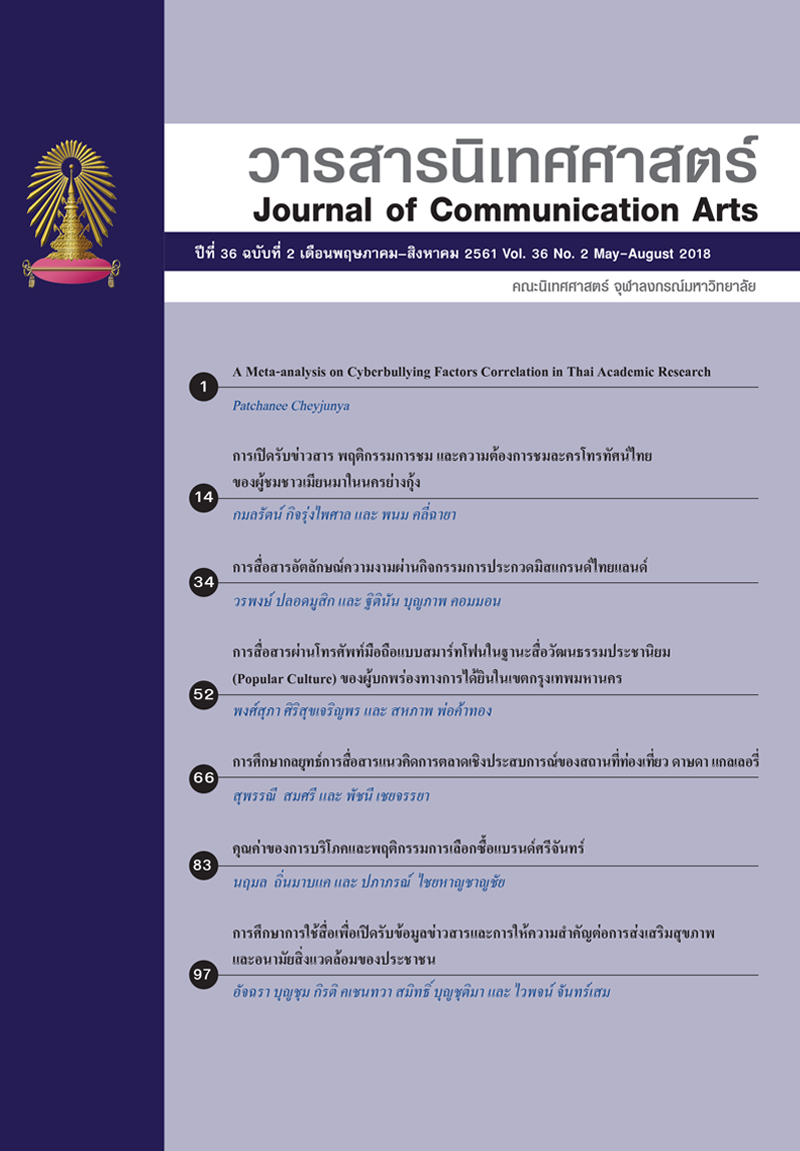A Meta-analysis on Cyberbullying Factors Correlation in Thai Academic Research
Main Article Content
บทคัดย่อ
บทความวิจัยเรื่องการวิเคราะห์ความสัมพันธ์ระหว่างตัวแปรการข่มเหงรังแกออนไลน์ในผลงานวิชาการของไทยด้วยวิธีการสังเคราะห์เชิงอภิมาน มีวัตถุประสงค์ศึกษาและรวบรวมองค์ความรู้ด้านการข่มเหงรังแกออนไลน์ในบริบทของไทย ด้วยการสังเคราะห์เชิงอภิมาน ผ่านตัวแปรและผลวิจัยต่างๆ ที่รวบรวมได้จากงานวิชาการของไทยที่ปรากฏบนฐานข้อมูลวิชาการในประเทศไทย จำนวน 3 ฐาน ได้แก่ (1) ระบบฐานข้อมูลศูนย์ดัชนีการอ้างอิงวารสารไทย (Thai-Journal Citation Index Centre: TCI) (2) ระบบฐานข้อมูลวารสารอิเล็กทรอนิกส์กลางของประเทศไทย (Thai Journals Online: ThaiJO) และ (3) ระบบฐานข้อมูลโครงการเครือข่ายห้องสมุดในประเทศไทย (Thai Library Integrated System: ThaiLIS) จากการสืบค้นเบื้องต้น พบว่า มีผลงานวิชาการที่ใกล้เคียงกับเนื้อหาด้านการข่มเหงรังแกออนไลน์ แต่ไม่เฉพาะเจาะจงมากนัก จำนวน 6,679 รายการ โดยเมื่อทำการพิจารณาคัดกรองเนื้อหาที่มีความเกี่ยวข้อง ด้วยวิธีการลดทอนข้อมูล (Data Reduction) พบผลงานวิชาการที่ผ่านการคัดกรองเนื้อหา 67 รายการ จากนั้นนำเนื้อหาดังกล่าวมาวิเคราะห์เนื้อหาอย่างเป็นระบบ และทำการสังเคราะห์เชิงอภิมาน โดยคัดเลือกเฉพาะผลงานวิชาการที่มีการทดสอบสมมติฐานด้วยสถิติ t-test และ F-test คำนวณเป็นค่าดัชนีมาตรฐาน เพื่อสรุปความสัมพันธ์และอิทธิพลของตัวแปรที่ศึกษา สามารถจำแนกได้เป็น กลุ่มตัวแปรสำคัญ จำนวน 5 กลุ่ม ประกอบด้วยกลุ่มตัวแปรอิสระ 3 ตัว และกลุ่มตัวแปรตาม 2 ตัว ที่มีคู่ความสัมพันธ์ในสมมติฐาน (มีสถานะเป็นหน่วยวิเคราะห์) รวม 394 คู่ ทั้งนี้ ผลจากการสรุปขนาดอิทธิพลและความสัมพันธ์ด้วยการวิเคราะห์ค่าดัชนีมาตรฐาน ในขั้นตอนการสังเคราะห์เชิงอภิมาน พบว่า กลุ่มตัวแปรที่มีขนาดอิทธิพลและความสัมพันธ์มากที่สุดคือ กลุ่มตัวแปรการเปิดรับสื่อ (d = -1.0289, r = -0.4569)
Article Details
เอกสารอ้างอิง
http://enough.org/stats_cyberbullying
Gerhards, J., Schafer, M. (2010) “Is the internet a better public sphere? Comparing old and new media in the USA and Germany” Sage Journals. Jan 19. Retrieved from http://nms.sagepub.com
Hofstede, G., & Bond, M. H. (1984). Hofstede’s culture dimensions: An independent validation using Rokeach’s Value Survey. Journal of Cross-Cultural Psychology, 15(4), 417-433.
Kotrlik, J.W., &Jabor, K. (2003). The Incorporation of Effect Size in Information Technology,
Learning, and Performance Research. Information Technology, Learning, and Performance Journal. 21(1) pp.1-7.
Kotrlik, J.W., Williams, H.A., &Jabor, K. (2011). Reporting and Interpreting Effect Size in
Quantitative Agricultural Education Research. Journal of Agricultural Education. 52(1) pp. 132-142.
McAfee. (2014). Teens and the Screen Study: Exploring Online Privacy, Social Networking and Cyberbullying. Retrieve May 18, 2018 from https://www.mcafee.com/us/about/
news/2014/q2/20140603-01.aspx
MethineeSuwannaki. (2017). Legal Measures to Protect Child and Juvenile from Cyber-Bullying.
Naresuan University Law Journal, 10(2) pp. 49-70.
NSPCC. (2016). What Children Are Telling Us About Bullying: Childline Bullying Report 2015/16.London, UK: NSPCC.
Ojanen, T., Boonmongkon, P., Samakkeekarom, R., Samoh, N. Cholratana, M., Guadamuz, T., (2015). “Connections Between Online Harassment and Offine Violence among Youth in Central Thailand”. Child Abuse Negl. 2015 Jun; 44: pp. 159-169.
Sawilowsky, S. (2009). New Effect Size Rules of Thumb. Journal of Modern Applied Statistical
Methods. 8(2) pp. 467–474.
Slonje, R., Smith, P.K., and Frisen, A. (2012) “The Nature of Cyberbullying and Strategies for Prevention.” Computer in Human Behaviors. Retrieved April 24, 2018, from http://www.elsevier.com/locate/comphumbeh.
The Children's Society and YoungMinds. (2018). Safety Net: Cyberbullying’s Impact on Young
People’s Mental Health. London, UK: The Children's Society and YoungMinds.


